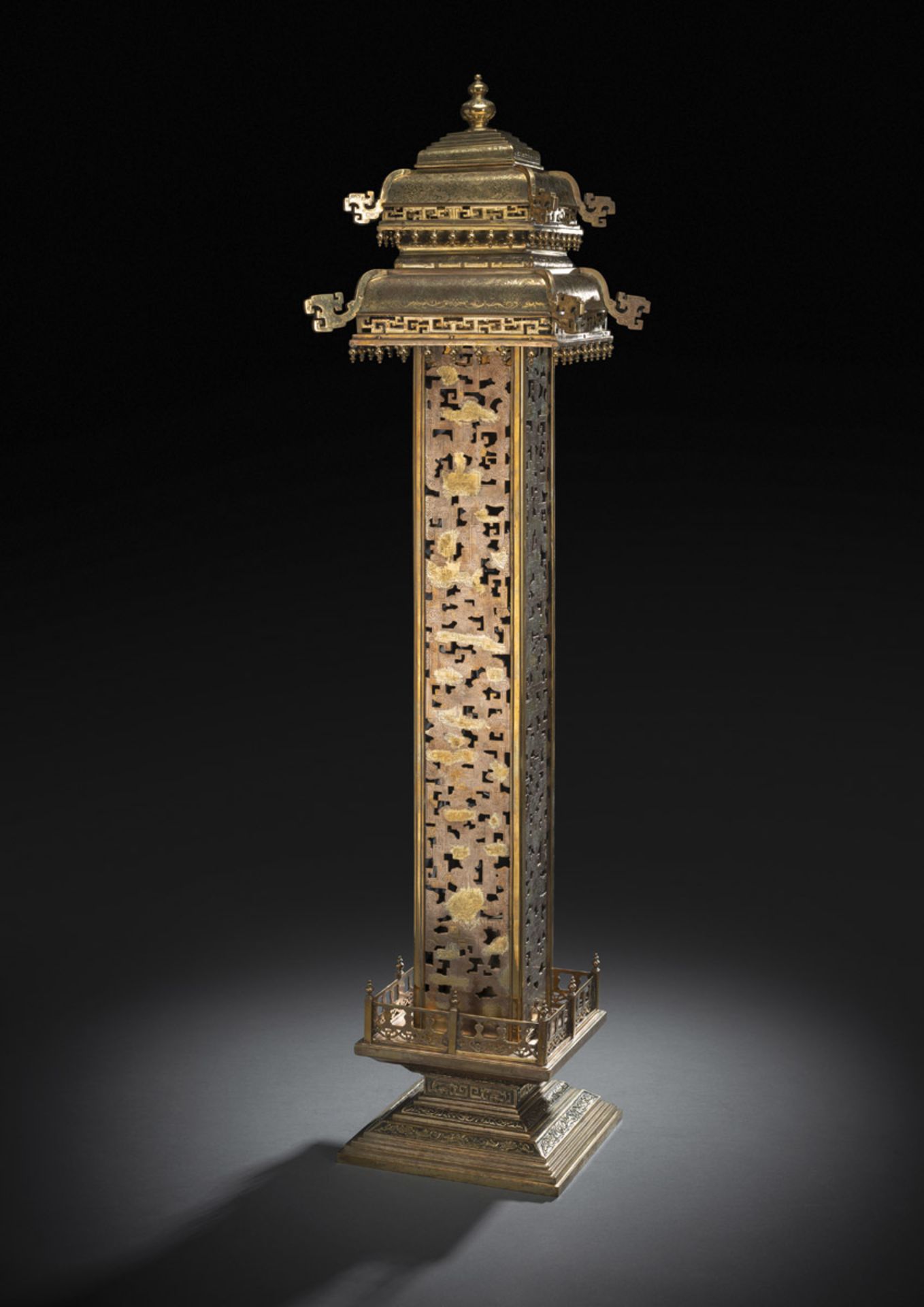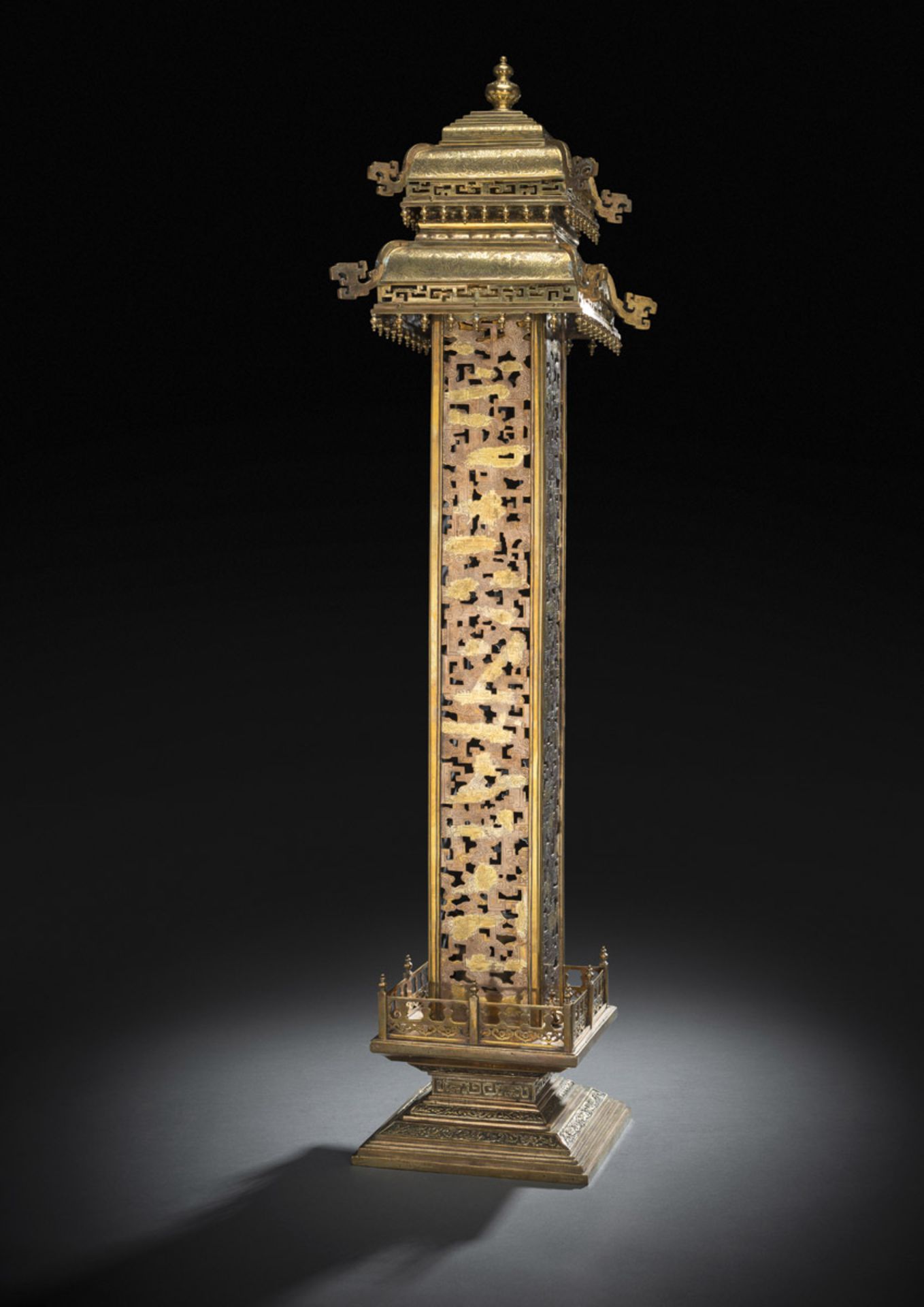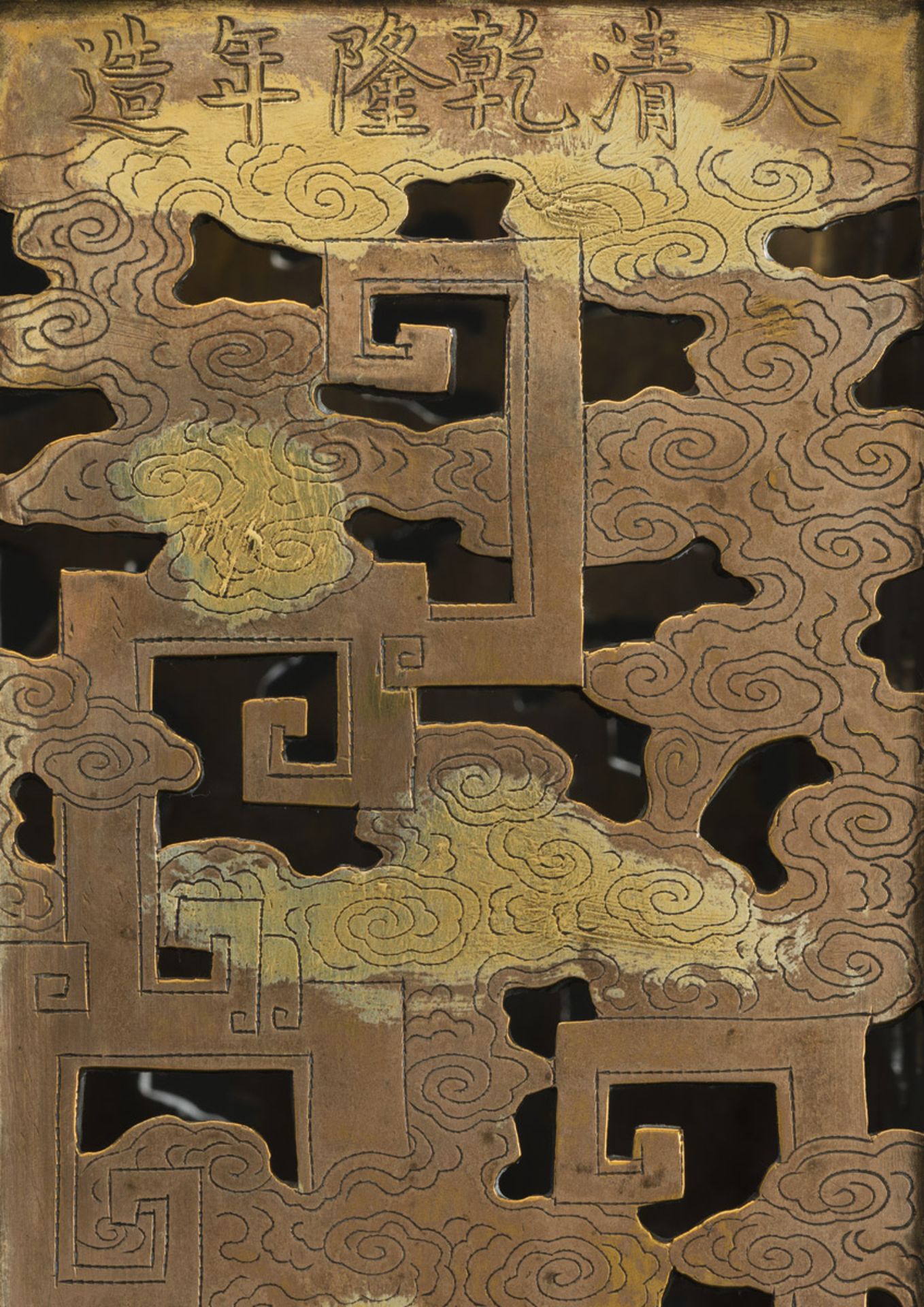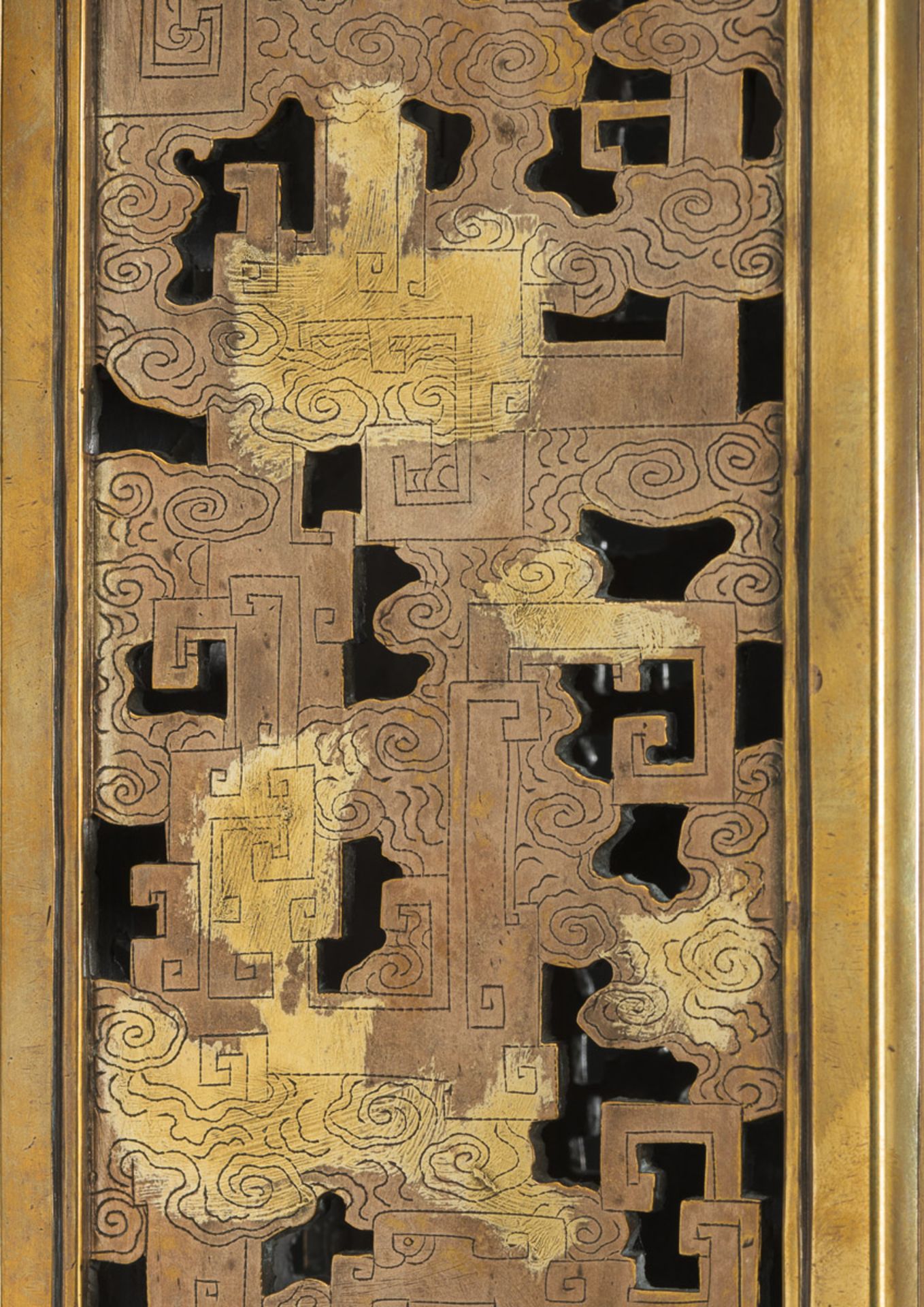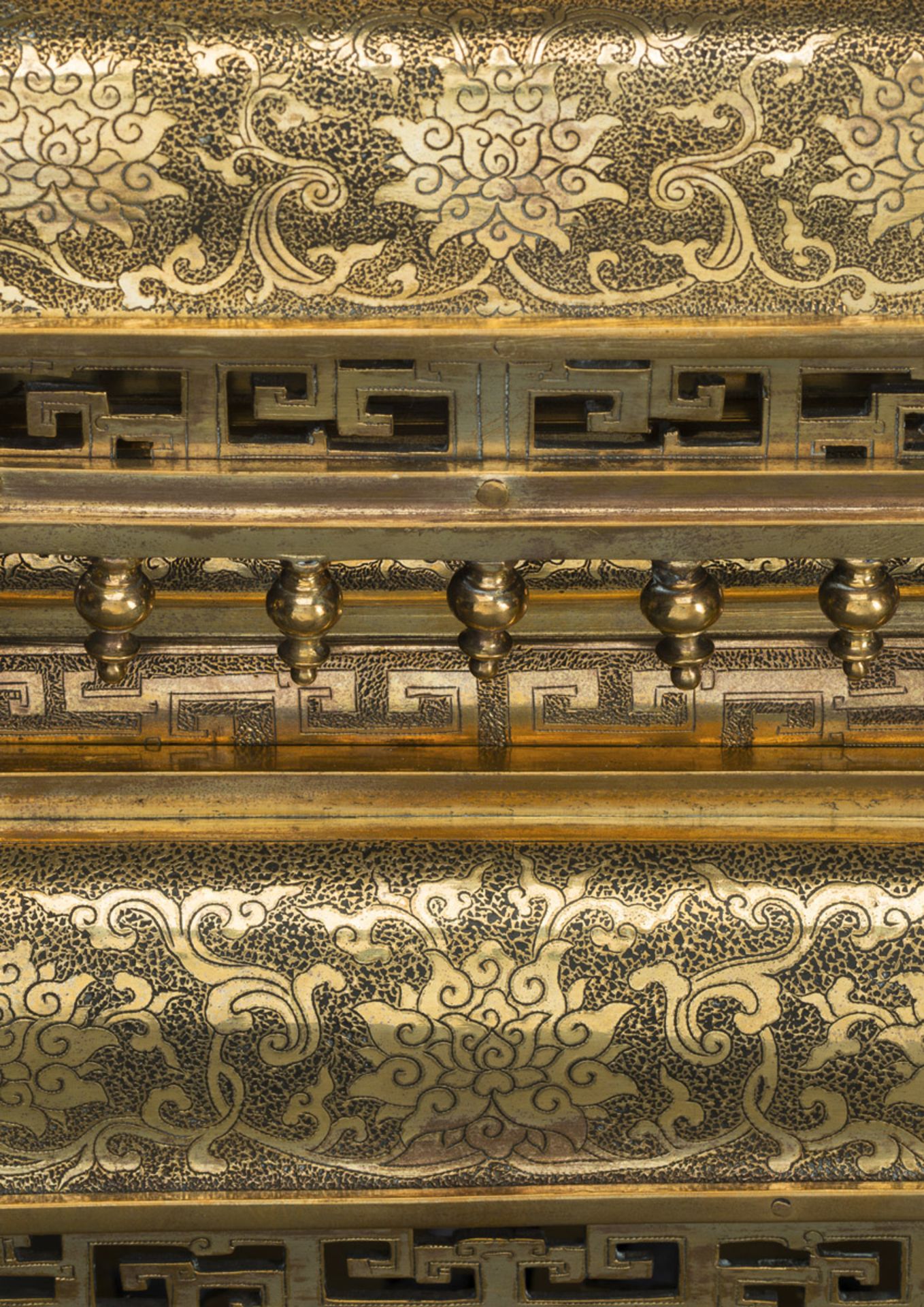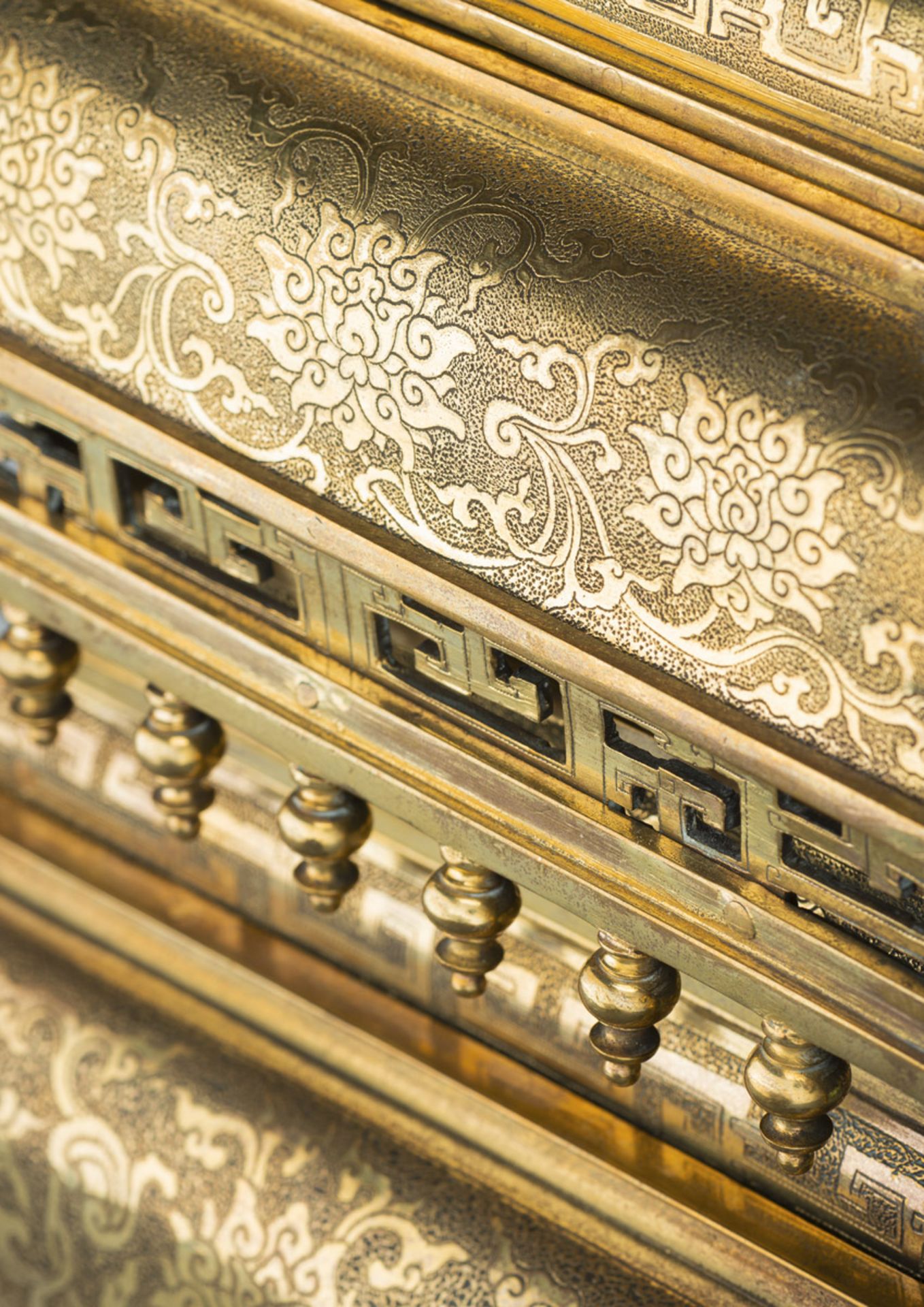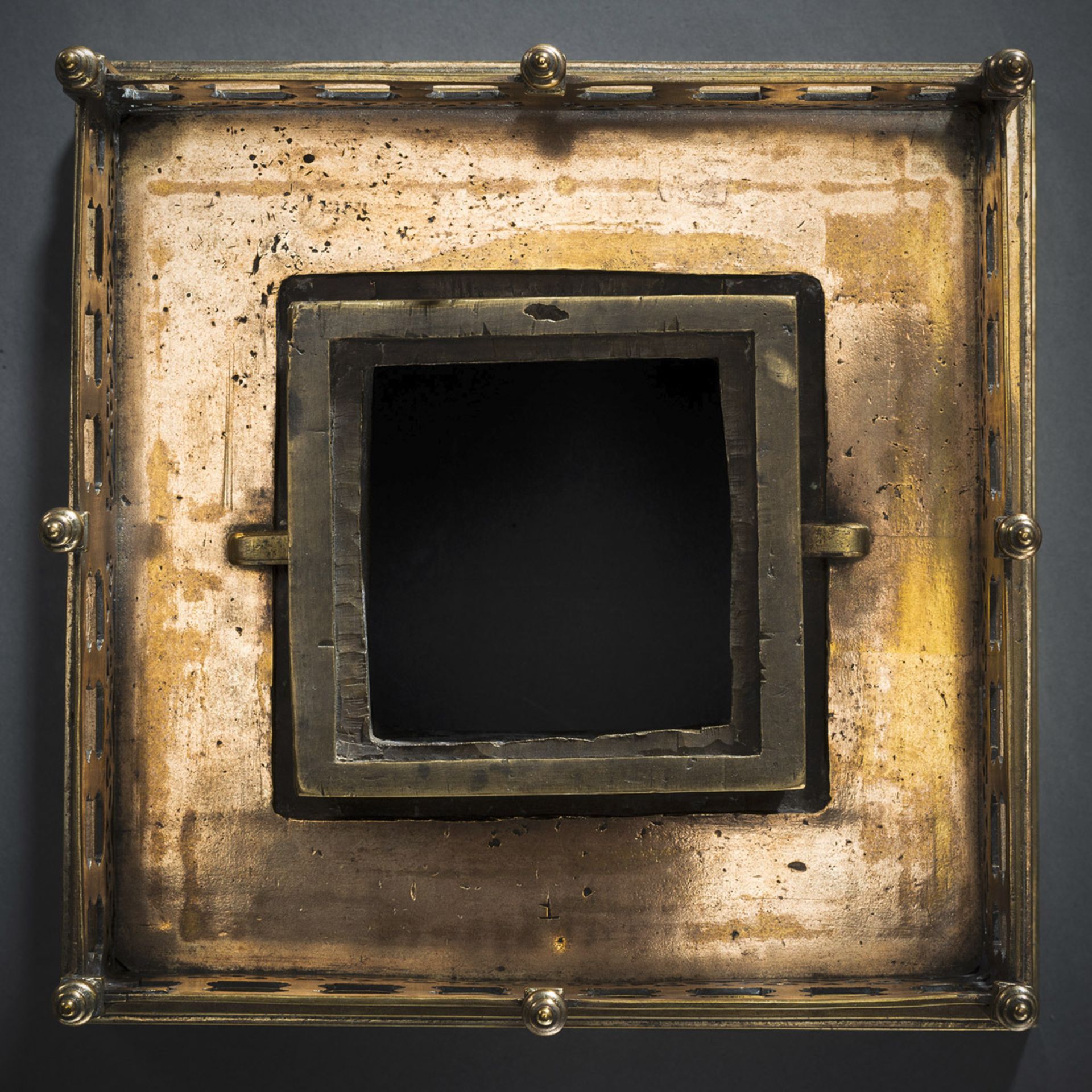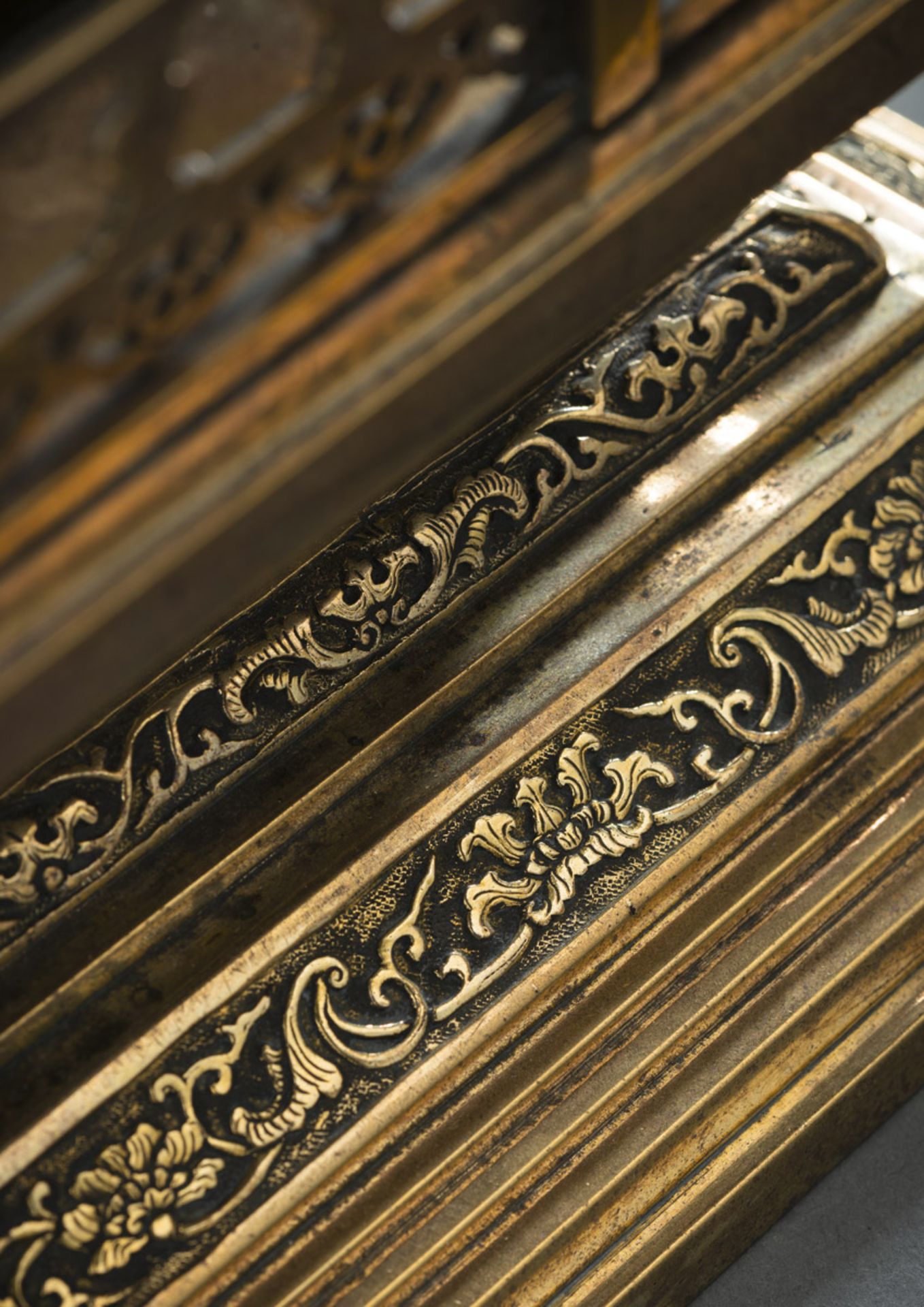9
AN EXTREMELAY RARE IMPERIAL PAVILION SHAPED INCENSE BURNER 'XIANTONG'
In Asian Art
China, Qianlong six-character mark and period
H. 110 cm
Very elegant part-gilt bronze incense burner with decoration of dragon and lotus as aroma burner, in the shape of a pavilion, with square body and stand. The finial in form of a pavilion with two-story eaves with excellent decoration of lotus. The body in finely executed aperture with gold-splashed dragon decoration. The stand with decoration of kuilong dragon and curved leafy branches. Marked daqing qianlong nian zao (made in the Qianlong period of the great Qing) below the eaves on the body. Dragon heads have been decorated on the four corners of the attachment as holders for hanging tassels. These hooks correspond to the hangings of a Chinese classical lantern stand and were described in the imperial archives as longgua (dragon hook). The stand of this incense burner is a so-called xumi stand in Chinese Architecture. The Chinese word Xumi refers to the Buddhist sacred Mount Meru as the center of the universe. The Xumi stand was very often used as the stand of the seated Buddha in Vajrasana and is therefore also known as the Vajra stand in Chinese Buddhism and classical architecture in China. During the Ming and Qing period, such large incense burners in a size of more than 1 meter in height were used more as aroma burners and usually placed as a pair in front of the imperial throne in the great hall, such as a pair of imperial xiangtong in a size of 112 cm in the form of a pavilion with two-story eaves with decoration of swastika and character shou (Long Life) made of gold, made in Tongzhi period, which are still in the collection of the Palace Museum in Beijing. According to the research of the scholar Wan Xiufeng of the Palace Museum in Beijing, all xiangtong in the main large halls including Taihe Hall, Zhonghe Hall and Baohe Hall in the Forbidden City which were placed there, had covers in the form of two-story eaves, while xiangtong with attachments in the form of one-story eaves were placed only in smaller palaces.
Important German aristocratic private collection, assembled in China prior to 1904 and owned by the family since then
In the imperial archives of the Qing period, these aroma burners were usually recorded as xiangtong (pipe for aroma) and sometimes as xiangting (pavilion for incense), but xiangting also referred to the architectural construction of a pavilion in which the emperor had incense used during a ritual. The xiangtong incense burner usually consists of three parts: a lid in the shape of a one-story or two-story pavilion roof, the body in the shape of a round or square tube, and a stand. In the archives for the palace interiors and in the archives for the works of the imperial workshop zaobanchu in the Qianlong period, there are many notes on xiangtong made of various materials such as gold, gilt bronze, cloisonné, zitan, jade, etc. Some of these large ones, like the present lot, were placed as objects in front of the imperial throne and some as small scented containers were placed on furniture such as desks. Most of them had a body in the shape of a round tube and rarely these were worked in a square shape. For example, in the published imperial archives of the zaobanchu in the Qianlong period, one can find the following notes about the making of the large bronze xiangtong with a body in the shape of a square tube for the palace hall to perform according to the imperial order.
According to the archive in the zhuluchu (burner casting department) in the zaobanchu on the 6th day of the chin. 3rd month in the 7th year of the Qianlong period (1742), "Mr Fobao, with the official title Langzhong, submitted a painted design on paper of kuilong dragon and luduan for the emperor to look at. The Emperor issued the order: 'Make kuilong and luduan, each in two pairs according to this design, add two matched pairs of fang longgua xiangtong (square xiangtong with dragon hooks) as a combination, first draw the design on paper for the Emperor to view, then have (xiangtong) made only with the Emperor's approval'." On the 10th day of the chin. 8th. Month in the same year, Mr. Bai Shixiu with the official title Siku submitted a pair of "longgua fang xiangtong" (square xiangtong with dragon hooks) to the court eunuch Hu Shijie, and the Emperor issued the order: "Deliver longgua xiangtong (xiangtong with dragon hooks) together with luduan for Yuanmingyuan Palace and place them in hall there after the luduan have been made." On the 29th day of the Chinese 8th month this year, a pair of xiangtong with dragon hooks and a pair of luduan were delivered together to Yuanmingyuan Palace and placed in the hall there. On the 26th day of the Chinese 10th month, Mr. Bai Shixiu submitted the other pair of "longgua fang xiangtong" (square xiangtong with dragon hooks) to the court eunuch Hu Shijie. With these archives, it can be found that large metal xiangtong were placed together with luduan as a fixed combination in the halls of the palace. Luduan were usually placed only in the important great palace hall, such as Taihe Hall as the ceremonial centre of imperial power in the Forbidden City. In the imperial archives from the Qianlong period, bronze xiangtong with dragon hooks were still made for the other important halls, i.e. Baohe Hall, Yangxin Hall and Wenhua Hall according to the imperial order. Emperor Qianlong had used xiangtong from the Ming period reworked for further use, such as on the 2nd day of the chin. 2nd month in the 35th year of the Qianlong period (1770) he issued the order, "Remove the Wanli mark from a pair of xiangtong and add the daqing qianlong nian zhi mark (made in the Qianlong period of the Great Qing)." In addition, stands of other objects were used as stands of xiangtong in the Qianlong period. For example, on the 10th of the Chinese 2nd month in the 10th year of the Qianlong period (1745), the archives record that Mr Bai Shixiu, with the official title of Siku, submitted a gilded pedestal with decoration of kuilong dragons and scrolled leafy branches to the court eunuch Hu Shijie. The emperor then issued the order: "Remove the top plate on the pedestal and use the pedestal as a stand of chuien xiangtong (xiangtong as a symbol of the spread of the imperial graces)". The incense burner chuien xiangtong is a very special type of xiangtong. The present lot here is this type of aroma burner chuien xiangtong with a hook attached to the top of the body, which is made in a breakthrough. It is used to hang the special imperial incense spiral chuienxiang (incense as a symbol of the spread of the imperial graces). The incense spiral chuienxiang originated from the very expensive incense spiral longguaxiang (incense in the shape of a hanging dragon) from the court of the Ming period. According to the archive on the 14th day of the Chinese 12th month in the 3rd year of the Yongzheng period (1725), Emperor Yongzheng issued the order: "Rename the incense longguaxiang to chuienxiang since then with this order." The incense spiral chuienxiang was very popular with Emperor Yongzheng and Qianlong, although making this incense spiral was seht much more costly and time-consuming than making incense. It was not until the 36th year of the Qianlong period (1771) that the imperial order was issued, "Do not make any more incense spiral chuienxiang since then with this order", because Emperor Qianlong checked the cost of various types of incense at court during this period and found that 80 incense sticks cost a total of only 3 liang 2 qian 8 fen silver, but for 20 incense spiral chuienxiang there was a cost of 48 liang 9 qian 3 fen 8 li silver.
Literature:
- Wan, Xiufeng "qingdai gongting de chuienxiang yu chuien xiangtong" (Incense chuienxiang and incense burner chuien xiangtong in the imperial court of the
China, Qianlong-Sechezeichenmarke und Periode
H. 110 cm
Sehr eleganter Weihrauchbrenner aus Bronze mit Dekor von Drachen und Lotus als Aromabrenner, teils feuervergoldet, in Gestalt eines Pavillons, mit viereckigem Korpus und Stand. Die Bekrönung in Form einer zweistöckiger Pavillonsdachtraufe mit exzellentem Dekor von Lotus. Der Korpus in fein ausgeführtem Durchbruch mit goldgeflecktem Drachen-Dekor. Der Stand mit Dekor von Kuilong-Drachen und geschwungen Blattzweigen. Unterhalb der Dachtraufe auf dem des Korpus gemarkt daqing qianlong nian zao (hergestellt in der Qianlong Periode der großen Qing). An den vier Ecken des Aufsatzed wurden Drachenköpfe als Halterungen für hängende Quaste dekoriert. Diese Haken entsprechen den Aufhängungen eines chinesischen klassischen Laternengestells und wurden im kaiserlichen Archiv als longgua (Drachen-Haken) beschrieben. Der Stand dieses Weihrauchbrenners ist in der chinesischen Architektur ein sogenannter Xumi-Stand. Das chinesische Wort Xumi bezieht sich auf den buddhistischen heiligen Berg Meru als Zentrum des Universums. Der Xumi-Stand wurde sehr häufig als Stand des sitzenden Buddha in Vajrasana verwendet und ist daher auch als Vajra-Stand im chinesischen Buddhismus und in der klassischen Architektur in China bekannt. In Ming- und Qing-Zeit wurden solche große Weihrauchbrenner in einer Größe von mehr als 1 Meter Höhe mehr als Aromabrenner verwendet und normalerweise als Paar vor dem kaiserlichen Thron in der großer Halle platziert, wie zum Beispiel ein Paar kaiserliche xiangtong in einer Größe von 112 cm in Gestalt eines Pavillons mit zweistöckiger Dachtraufe mit Dekor von Swastika und Charakter shou (Langem Leben) aus Gold, hergestellt in der Periode Tongzhi, die sich heute noch in der Sammlung des Palastmuseum in Peking befinden. Gemäß der Forschung des Wissenschaftlers Wan Xiufeng des Palastmuseums in Peking wurden alle xiangtong in den wichtigsten großen Hallen inklusive der Halle Taihe, Zhonghe und Baohe in der Verbotenen Stadt den Deckel in Gestalt der zweistöckigen Dachtraufe platziert, während hingegen xiangtong mit Aufsätzen in Gestalt der einstöckigen Dachtraufe lediglich in kleineren Palästen platziert wurden.
Aus bedeutendem aristokratischen Besitz, vor 1904 in China gesammelt und seither in Deutschland durch Erbschaft durchgehend in derselben Familie
In den kaiserlichen Archiven der Qing-Zeit wurden diese Aromabrenner normalerweise als xiangtong (Rohr für Aroma) und manchmal als xiangting (Pavillon für Weihrauch) aufgezeichnet, aber xiangting bezog sich auch auf den architektonischen Bau eines Pavillons, in dem der Kaiser während eines Ritual Weihrauch verwenden lies. Der Weihrauchbrenner xiangtong besteht normalerweise aus drei Teilen: ein Deckel in Gestalt einer einstöckigen oder zweistöckigen Pavillonsdachtraufes, der Korpus in Gestalt eines rundem oder viereckigem Rohr, und ein Stand. In den Archiven über die Inneneinrichtungen des Palastes und in den Archiven über die Arbeiten der kaiserlichen Werkstatt zaobanchu in der Qianlong Periode gibt es viele Notizen über xiangtong hergestellt aus den diversen Materialien wie z. B. Gold, vergoldeter Bronze, Cloisonné, Zitan, Jade usw. Manche dieser großen, wie das hier vorliegende Stück, waren als Objekte vor dem kaiserlichen Thron platziert und manche als kleine Duftbehälter wurden auf Möbeln wie zum Beispiel Schreibtischen platziert. Die meisten hatten einen Korpus in Gestalt eines runden Rohrs und sehr selten wurden diese in quadratischer Form gearbeitet. In den publizierten kaiserlichen Archiven der zaobanchu in der Qianlong-Periode kann man z. B. die folgenden Notizen über die Herstellung der großen xiangtong aus Bronze mit einem Korpus in Gestalt einer viereckigen Rohrs für die Palasthalle zur Auführung gemäß des kaiserlichen Befehls finden:
Gemäß dem Archiv in der Abteilung zhuluchu (Abteilung für Gießen des Brenners) im zaobanchu am 6. Tag des chin. 3. Monates im 7. Jahr der Qianlong Periode (1742) „reichte Herr Fobao mit dem Beamtentitel Langzhong einen gemalten Entwurf auf Papier von Kuilong-Drachen und Luduan zum Betrachten für den Kaiser ein. Der Kaiser erteilte den Befehl: ‚Stellt Kuilong-Drachen und Luduan, je in zwei Paaren nach diesem Entwurf her, ergänzt noch zwei angepasste Paare von fang longgua xiangtong (viereckige xiangtong mit Drachen-Haken) als Kombination dazu, zeichnet zuerst den Entwurf auf Papier zum Betrachten durch den Kaiser, lasst (xiangtong) erst mit der Zustimmung des Kaisers dann herstellen’.“ Am 10. Tag des chin. 8. Monates im gleichen Jahr reichte Herr Bai Shixiu mit dem Beamtentitel Siku ein Paar „longgua fang xiangtong“ (viereckige xiangtong mit Drachen-Haken) an den Hofeunuchen Hu Shijie ein, und der Kaiser erteilte den Befehl: „Liefert longgua xiangtong (xiangtong mit Drachen-Haken) zusammen mit Luduan für den Palast Yuanmingyuan und platziert sie in Halle dort nachdem die Luduan fertig hergestellt wurden.“ Am 29. Tag des chin. 8. Monates in diesem Jahr wurden ein Paar xiangtong mit Drachen-Haken und ein Paar Luduan zusammen in den Palast Yuanmingyuan geliefert und in der Halle dort platziert. Am 26. Tag des chin. 10. Monate reichte Herr Bai Shixiu das andere Paar „longgua fang xiangtong“ (viereckige xiangtong mit Drachen-Haken) an den Hofeunuchen Hu Shijie ein. Mit diesen Archiven kann man herausfinden, dass große xiangtong aus Metall zusammen mit Luduan als eine festgelegte Kombination in den Hallen des Palastes platziert wurden. Luduan wurde normalerweise lediglich in der wichtigen großen Palasthalle platziert, wie z. B. in der Halle Taihe als zeremoniellem Zentrum der kaiserlichen Macht in der verbotenen Stadt. In den kaiserlichen Archiven aus der Qianlong-Periode wurden noch xiangtong aus Bronze mit Drachen-Haken für die anderen wichtigen Hallen, also Halle Baohe, Halle Yangxin und Halle Wenhua nach dem kaiserlichen Befehl hergestellt. Kaiser Qianlong lies gebrauchte xiangtong aus der Ming-Zeit für die weitere Verwendung umarbeiten, wie z. B. am 2. Tag des chin. 2. Monates im 35. Jahr der Qianlong Periode (1770) erteilte er den Befehl, „Entfernt die Wanli-Marke von einem Paar xiangtong und ergänzt die Marke daqing qianlong nian zhi (hergestellt in der Qianlong Periode der großen Qing).“ Außerdem wurden in der Qianlong-Periode Stände von anderen Objekten als Stände von xiangtong verwendet. So ist im Archiv am 10. des chin. 2. Monates im 10. Jahr der Qianlong Periode (1745) verzeichnet, dass Herr Bai Shixiu mit dem Beamten-Titel Siku einen vergoldeten Sockel mit Dekor von Kuilong-Drachen und gerollten Blattzweigen an den Hofeunuchen Hu Shijie einreichte. Der Kaiser erteilte daraufhin den Befehl: „Entfernt die obere Platte auf dem Sockel und verwendet den Sockel als Stand von chuien xiangtong (xiangtong als Symbol der Verbreitung von den kaiserlichen Gnaden)“. Der Weihrauchbrenner chuien xiangtong ist ein sehr spezieller Typus von xiangtong. Bei dem hier vorliegenden Stück handelt sich eben um diesen Typus Aromabrenner chuien xiangtong mit einen Haken, der hier oben im Inneren des in Durchbruch gearbeiteten Korpus angebracht ist. Er dient zum Aufhängen des speziellen kaiserlichen Weihrauchs chuienxiang (Weihrauch als Symbol der Verbreitung von den kaiserlichen Gnaden). Der Weihrauch chuienxiang entstand aus der sehr teuren Räucherspirale longguaxiang (Weihrauch in Gestalt eines aufhängenden Drachens) aus dem Hof der Ming-Zeit. Gemäß dem Archiv am 14. Tag des chin. 12. Monates im 3. Jahr der Yongzheng Periode (1725) erteilte Kaiser Yongzheng den Befehl: „Benennt den Weihrauch longguaxiang in chuienxiang um seither mit diesem Befehl.“ Der Weihrauch chuienxiang in Form von Stäbchen oder Spirale war sehr beliebt bei Kaiser Yongzheng und Qianlong, obwohl die Herstellung diese Weihrauchs seht viel kostspieliger und zeitaufwändiger war, als
China, Qianlong six-character mark and period
H. 110 cm
Very elegant part-gilt bronze incense burner with decoration of dragon and lotus as aroma burner, in the shape of a pavilion, with square body and stand. The finial in form of a pavilion with two-story eaves with excellent decoration of lotus. The body in finely executed aperture with gold-splashed dragon decoration. The stand with decoration of kuilong dragon and curved leafy branches. Marked daqing qianlong nian zao (made in the Qianlong period of the great Qing) below the eaves on the body. Dragon heads have been decorated on the four corners of the attachment as holders for hanging tassels. These hooks correspond to the hangings of a Chinese classical lantern stand and were described in the imperial archives as longgua (dragon hook). The stand of this incense burner is a so-called xumi stand in Chinese Architecture. The Chinese word Xumi refers to the Buddhist sacred Mount Meru as the center of the universe. The Xumi stand was very often used as the stand of the seated Buddha in Vajrasana and is therefore also known as the Vajra stand in Chinese Buddhism and classical architecture in China. During the Ming and Qing period, such large incense burners in a size of more than 1 meter in height were used more as aroma burners and usually placed as a pair in front of the imperial throne in the great hall, such as a pair of imperial xiangtong in a size of 112 cm in the form of a pavilion with two-story eaves with decoration of swastika and character shou (Long Life) made of gold, made in Tongzhi period, which are still in the collection of the Palace Museum in Beijing. According to the research of the scholar Wan Xiufeng of the Palace Museum in Beijing, all xiangtong in the main large halls including Taihe Hall, Zhonghe Hall and Baohe Hall in the Forbidden City which were placed there, had covers in the form of two-story eaves, while xiangtong with attachments in the form of one-story eaves were placed only in smaller palaces.
Important German aristocratic private collection, assembled in China prior to 1904 and owned by the family since then
In the imperial archives of the Qing period, these aroma burners were usually recorded as xiangtong (pipe for aroma) and sometimes as xiangting (pavilion for incense), but xiangting also referred to the architectural construction of a pavilion in which the emperor had incense used during a ritual. The xiangtong incense burner usually consists of three parts: a lid in the shape of a one-story or two-story pavilion roof, the body in the shape of a round or square tube, and a stand. In the archives for the palace interiors and in the archives for the works of the imperial workshop zaobanchu in the Qianlong period, there are many notes on xiangtong made of various materials such as gold, gilt bronze, cloisonné, zitan, jade, etc. Some of these large ones, like the present lot, were placed as objects in front of the imperial throne and some as small scented containers were placed on furniture such as desks. Most of them had a body in the shape of a round tube and rarely these were worked in a square shape. For example, in the published imperial archives of the zaobanchu in the Qianlong period, one can find the following notes about the making of the large bronze xiangtong with a body in the shape of a square tube for the palace hall to perform according to the imperial order.
According to the archive in the zhuluchu (burner casting department) in the zaobanchu on the 6th day of the chin. 3rd month in the 7th year of the Qianlong period (1742), "Mr Fobao, with the official title Langzhong, submitted a painted design on paper of kuilong dragon and luduan for the emperor to look at. The Emperor issued the order: 'Make kuilong and luduan, each in two pairs according to this design, add two matched pairs of fang longgua xiangtong (square xiangtong with dragon hooks) as a combination, first draw the design on paper for the Emperor to view, then have (xiangtong) made only with the Emperor's approval'." On the 10th day of the chin. 8th. Month in the same year, Mr. Bai Shixiu with the official title Siku submitted a pair of "longgua fang xiangtong" (square xiangtong with dragon hooks) to the court eunuch Hu Shijie, and the Emperor issued the order: "Deliver longgua xiangtong (xiangtong with dragon hooks) together with luduan for Yuanmingyuan Palace and place them in hall there after the luduan have been made." On the 29th day of the Chinese 8th month this year, a pair of xiangtong with dragon hooks and a pair of luduan were delivered together to Yuanmingyuan Palace and placed in the hall there. On the 26th day of the Chinese 10th month, Mr. Bai Shixiu submitted the other pair of "longgua fang xiangtong" (square xiangtong with dragon hooks) to the court eunuch Hu Shijie. With these archives, it can be found that large metal xiangtong were placed together with luduan as a fixed combination in the halls of the palace. Luduan were usually placed only in the important great palace hall, such as Taihe Hall as the ceremonial centre of imperial power in the Forbidden City. In the imperial archives from the Qianlong period, bronze xiangtong with dragon hooks were still made for the other important halls, i.e. Baohe Hall, Yangxin Hall and Wenhua Hall according to the imperial order. Emperor Qianlong had used xiangtong from the Ming period reworked for further use, such as on the 2nd day of the chin. 2nd month in the 35th year of the Qianlong period (1770) he issued the order, "Remove the Wanli mark from a pair of xiangtong and add the daqing qianlong nian zhi mark (made in the Qianlong period of the Great Qing)." In addition, stands of other objects were used as stands of xiangtong in the Qianlong period. For example, on the 10th of the Chinese 2nd month in the 10th year of the Qianlong period (1745), the archives record that Mr Bai Shixiu, with the official title of Siku, submitted a gilded pedestal with decoration of kuilong dragons and scrolled leafy branches to the court eunuch Hu Shijie. The emperor then issued the order: "Remove the top plate on the pedestal and use the pedestal as a stand of chuien xiangtong (xiangtong as a symbol of the spread of the imperial graces)". The incense burner chuien xiangtong is a very special type of xiangtong. The present lot here is this type of aroma burner chuien xiangtong with a hook attached to the top of the body, which is made in a breakthrough. It is used to hang the special imperial incense spiral chuienxiang (incense as a symbol of the spread of the imperial graces). The incense spiral chuienxiang originated from the very expensive incense spiral longguaxiang (incense in the shape of a hanging dragon) from the court of the Ming period. According to the archive on the 14th day of the Chinese 12th month in the 3rd year of the Yongzheng period (1725), Emperor Yongzheng issued the order: "Rename the incense longguaxiang to chuienxiang since then with this order." The incense spiral chuienxiang was very popular with Emperor Yongzheng and Qianlong, although making this incense spiral was seht much more costly and time-consuming than making incense. It was not until the 36th year of the Qianlong period (1771) that the imperial order was issued, "Do not make any more incense spiral chuienxiang since then with this order", because Emperor Qianlong checked the cost of various types of incense at court during this period and found that 80 incense sticks cost a total of only 3 liang 2 qian 8 fen silver, but for 20 incense spiral chuienxiang there was a cost of 48 liang 9 qian 3 fen 8 li silver.
Literature:
- Wan, Xiufeng "qingdai gongting de chuienxiang yu chuien xiangtong" (Incense chuienxiang and incense burner chuien xiangtong in the imperial court of the
China, Qianlong-Sechezeichenmarke und Periode
H. 110 cm
Sehr eleganter Weihrauchbrenner aus Bronze mit Dekor von Drachen und Lotus als Aromabrenner, teils feuervergoldet, in Gestalt eines Pavillons, mit viereckigem Korpus und Stand. Die Bekrönung in Form einer zweistöckiger Pavillonsdachtraufe mit exzellentem Dekor von Lotus. Der Korpus in fein ausgeführtem Durchbruch mit goldgeflecktem Drachen-Dekor. Der Stand mit Dekor von Kuilong-Drachen und geschwungen Blattzweigen. Unterhalb der Dachtraufe auf dem des Korpus gemarkt daqing qianlong nian zao (hergestellt in der Qianlong Periode der großen Qing). An den vier Ecken des Aufsatzed wurden Drachenköpfe als Halterungen für hängende Quaste dekoriert. Diese Haken entsprechen den Aufhängungen eines chinesischen klassischen Laternengestells und wurden im kaiserlichen Archiv als longgua (Drachen-Haken) beschrieben. Der Stand dieses Weihrauchbrenners ist in der chinesischen Architektur ein sogenannter Xumi-Stand. Das chinesische Wort Xumi bezieht sich auf den buddhistischen heiligen Berg Meru als Zentrum des Universums. Der Xumi-Stand wurde sehr häufig als Stand des sitzenden Buddha in Vajrasana verwendet und ist daher auch als Vajra-Stand im chinesischen Buddhismus und in der klassischen Architektur in China bekannt. In Ming- und Qing-Zeit wurden solche große Weihrauchbrenner in einer Größe von mehr als 1 Meter Höhe mehr als Aromabrenner verwendet und normalerweise als Paar vor dem kaiserlichen Thron in der großer Halle platziert, wie zum Beispiel ein Paar kaiserliche xiangtong in einer Größe von 112 cm in Gestalt eines Pavillons mit zweistöckiger Dachtraufe mit Dekor von Swastika und Charakter shou (Langem Leben) aus Gold, hergestellt in der Periode Tongzhi, die sich heute noch in der Sammlung des Palastmuseum in Peking befinden. Gemäß der Forschung des Wissenschaftlers Wan Xiufeng des Palastmuseums in Peking wurden alle xiangtong in den wichtigsten großen Hallen inklusive der Halle Taihe, Zhonghe und Baohe in der Verbotenen Stadt den Deckel in Gestalt der zweistöckigen Dachtraufe platziert, während hingegen xiangtong mit Aufsätzen in Gestalt der einstöckigen Dachtraufe lediglich in kleineren Palästen platziert wurden.
Aus bedeutendem aristokratischen Besitz, vor 1904 in China gesammelt und seither in Deutschland durch Erbschaft durchgehend in derselben Familie
In den kaiserlichen Archiven der Qing-Zeit wurden diese Aromabrenner normalerweise als xiangtong (Rohr für Aroma) und manchmal als xiangting (Pavillon für Weihrauch) aufgezeichnet, aber xiangting bezog sich auch auf den architektonischen Bau eines Pavillons, in dem der Kaiser während eines Ritual Weihrauch verwenden lies. Der Weihrauchbrenner xiangtong besteht normalerweise aus drei Teilen: ein Deckel in Gestalt einer einstöckigen oder zweistöckigen Pavillonsdachtraufes, der Korpus in Gestalt eines rundem oder viereckigem Rohr, und ein Stand. In den Archiven über die Inneneinrichtungen des Palastes und in den Archiven über die Arbeiten der kaiserlichen Werkstatt zaobanchu in der Qianlong Periode gibt es viele Notizen über xiangtong hergestellt aus den diversen Materialien wie z. B. Gold, vergoldeter Bronze, Cloisonné, Zitan, Jade usw. Manche dieser großen, wie das hier vorliegende Stück, waren als Objekte vor dem kaiserlichen Thron platziert und manche als kleine Duftbehälter wurden auf Möbeln wie zum Beispiel Schreibtischen platziert. Die meisten hatten einen Korpus in Gestalt eines runden Rohrs und sehr selten wurden diese in quadratischer Form gearbeitet. In den publizierten kaiserlichen Archiven der zaobanchu in der Qianlong-Periode kann man z. B. die folgenden Notizen über die Herstellung der großen xiangtong aus Bronze mit einem Korpus in Gestalt einer viereckigen Rohrs für die Palasthalle zur Auführung gemäß des kaiserlichen Befehls finden:
Gemäß dem Archiv in der Abteilung zhuluchu (Abteilung für Gießen des Brenners) im zaobanchu am 6. Tag des chin. 3. Monates im 7. Jahr der Qianlong Periode (1742) „reichte Herr Fobao mit dem Beamtentitel Langzhong einen gemalten Entwurf auf Papier von Kuilong-Drachen und Luduan zum Betrachten für den Kaiser ein. Der Kaiser erteilte den Befehl: ‚Stellt Kuilong-Drachen und Luduan, je in zwei Paaren nach diesem Entwurf her, ergänzt noch zwei angepasste Paare von fang longgua xiangtong (viereckige xiangtong mit Drachen-Haken) als Kombination dazu, zeichnet zuerst den Entwurf auf Papier zum Betrachten durch den Kaiser, lasst (xiangtong) erst mit der Zustimmung des Kaisers dann herstellen’.“ Am 10. Tag des chin. 8. Monates im gleichen Jahr reichte Herr Bai Shixiu mit dem Beamtentitel Siku ein Paar „longgua fang xiangtong“ (viereckige xiangtong mit Drachen-Haken) an den Hofeunuchen Hu Shijie ein, und der Kaiser erteilte den Befehl: „Liefert longgua xiangtong (xiangtong mit Drachen-Haken) zusammen mit Luduan für den Palast Yuanmingyuan und platziert sie in Halle dort nachdem die Luduan fertig hergestellt wurden.“ Am 29. Tag des chin. 8. Monates in diesem Jahr wurden ein Paar xiangtong mit Drachen-Haken und ein Paar Luduan zusammen in den Palast Yuanmingyuan geliefert und in der Halle dort platziert. Am 26. Tag des chin. 10. Monate reichte Herr Bai Shixiu das andere Paar „longgua fang xiangtong“ (viereckige xiangtong mit Drachen-Haken) an den Hofeunuchen Hu Shijie ein. Mit diesen Archiven kann man herausfinden, dass große xiangtong aus Metall zusammen mit Luduan als eine festgelegte Kombination in den Hallen des Palastes platziert wurden. Luduan wurde normalerweise lediglich in der wichtigen großen Palasthalle platziert, wie z. B. in der Halle Taihe als zeremoniellem Zentrum der kaiserlichen Macht in der verbotenen Stadt. In den kaiserlichen Archiven aus der Qianlong-Periode wurden noch xiangtong aus Bronze mit Drachen-Haken für die anderen wichtigen Hallen, also Halle Baohe, Halle Yangxin und Halle Wenhua nach dem kaiserlichen Befehl hergestellt. Kaiser Qianlong lies gebrauchte xiangtong aus der Ming-Zeit für die weitere Verwendung umarbeiten, wie z. B. am 2. Tag des chin. 2. Monates im 35. Jahr der Qianlong Periode (1770) erteilte er den Befehl, „Entfernt die Wanli-Marke von einem Paar xiangtong und ergänzt die Marke daqing qianlong nian zhi (hergestellt in der Qianlong Periode der großen Qing).“ Außerdem wurden in der Qianlong-Periode Stände von anderen Objekten als Stände von xiangtong verwendet. So ist im Archiv am 10. des chin. 2. Monates im 10. Jahr der Qianlong Periode (1745) verzeichnet, dass Herr Bai Shixiu mit dem Beamten-Titel Siku einen vergoldeten Sockel mit Dekor von Kuilong-Drachen und gerollten Blattzweigen an den Hofeunuchen Hu Shijie einreichte. Der Kaiser erteilte daraufhin den Befehl: „Entfernt die obere Platte auf dem Sockel und verwendet den Sockel als Stand von chuien xiangtong (xiangtong als Symbol der Verbreitung von den kaiserlichen Gnaden)“. Der Weihrauchbrenner chuien xiangtong ist ein sehr spezieller Typus von xiangtong. Bei dem hier vorliegenden Stück handelt sich eben um diesen Typus Aromabrenner chuien xiangtong mit einen Haken, der hier oben im Inneren des in Durchbruch gearbeiteten Korpus angebracht ist. Er dient zum Aufhängen des speziellen kaiserlichen Weihrauchs chuienxiang (Weihrauch als Symbol der Verbreitung von den kaiserlichen Gnaden). Der Weihrauch chuienxiang entstand aus der sehr teuren Räucherspirale longguaxiang (Weihrauch in Gestalt eines aufhängenden Drachens) aus dem Hof der Ming-Zeit. Gemäß dem Archiv am 14. Tag des chin. 12. Monates im 3. Jahr der Yongzheng Periode (1725) erteilte Kaiser Yongzheng den Befehl: „Benennt den Weihrauch longguaxiang in chuienxiang um seither mit diesem Befehl.“ Der Weihrauch chuienxiang in Form von Stäbchen oder Spirale war sehr beliebt bei Kaiser Yongzheng und Qianlong, obwohl die Herstellung diese Weihrauchs seht viel kostspieliger und zeitaufwändiger war, als
Asian Art
Sale Date(s)
Important Information
Bitte beachten Sie: Die Bietzulassung ist nur bei Vorlage eines gültigen Personalausweises möglich.
Please note: Bidding approvement is only possible with a copy of a valid passport.
Zu Aufgeld und Mehrwertsteuer prüfen Sie bitte das jeweilige Los.
For buyer's premium and VAT please check particular lot.
Terms & Conditions
Important notice: In order to ensure a proper execution of your bids, please make sure that your registration and bids must be submitted 48h before auction starts.
The auction is held in the name of NAGEL AUKTIONEN GmbH (hereinafter referred to as “Auctioneer”). The auctioneers act as its representative. They are publicly appointed and sworn auctioneers in accordance with § 34 Para. 5 of the Trade Regulation Act. The auction is thus a public auction within the meaning of § 383 Para. 3, p. 1 of the Civil Code.
1. Fundamentals of the auction The Auctioneer holds public auctions within the scope of §383 Paragraph 3 Sub-Clause 1 of the German Civil Code in its own name as consignee and for the account of the depositors (consignors) whose names are not disclosed. By taking part in the auction, the following auction conditions of the Auctioneer are accepted.
2. Defects a) All property items offered for auction can be viewed and inspected prior to the auction. The property items are second-hand. The catalogue descriptions are made to the best of the author’s knowledge and belief, but are for purposes of information exclusively and are not part of the contrac- tually agreed properties and condition of the items within the meaning of § 434 of the Civil Code, in particular they do not constitute guarantees within the meaning of § 443 of the Civil Code. The same applies to verbal or written information of all kinds, as well as the designation of the items when called. If an Internet catalogue is made in addition, the information in the printed version is nonethe- less authoritative. Impairments in the state of the items’ preservation are not stated in every case, so that lack of information likewise does not furnish grounds for an agreement on the quality of the items. The Auctioneer reserves the right to make corrections to catalogue information. These corrections take the form of written notices posted at the place of the auction and verbal corrections made by the Auctioneer immediately prior to the auction of the specific item. The corrected information takes the place of the catalogue descriptions. All items are offered for auction in the state in which they are found at the time of the auction. b) In the event of quality defects and defects of title claimed within 12 months after the knockdown, the Auctioneer shall undertake at his own discretion to assign his claims or to assert his claims directly against the Consignor. The condition for this is that the buyer has completely paid the bill for the auction. The costs of legal action taken against the Consignor are borne by the buyer, insofar as the Auctioneer receives no reimbursement of costs from the Consignor. The valuation of a recognized expert proving the defect and made at the expense of the buyer is necessary for the assertion of a claim for a quality defect. If claims made against the Consignor are successful, the Auctioneer shall refund only the purchase price to the buyer, matching payment with the return of the property. The buyer is still under obligation to pay the premium as compensation for the services of the Auctioneer. In all other respects, the Auctioneer shall assume no liability for quality defects and defects of title, insofar as the Auctioneer has fulfilled his obligations to exercise diligence. This shall not affect any liability of the Auctioneer for bodily harm or injury to health.
3. Bids a) Floor bids Each bidder must indicate his (her/its) name and address before the start of the auction. This holds even if he takes part in the auction as a representative. In this case, he must also indicate the name and address of the party he is representing. In cases of doubt, the bidder shall make acquisitions in his own name and for his own account. Each bidder must make a deposit before the start of the auction b) Absentee bids In order to ensure that written bids are properly executed, they must be made on the form provided for this purpose and received by the Auctioneer at least 48 hours before the start of the first day of the auction. The bidder is required to provide evidence of the receipt. For a written bid to be effective, it must contain detailed informa- tion on the person or company of the bidder as well as the lot number. A telephone number at which the bidder can regularly be reached must be indicated when the bid is made. The bid is restricted exclusively to the lot number indicated. Written bids are only used by the Auctioneer with the amount that is necessary to bid over another bid that has been made. Telephone bids will be accepted by telephoning the bidder before the desired lot is called. This is only done for lots with an estimated price of € 750.00 or more. The condition for taking part by telephone is a written notice received by the Auctioneer no later than 48 hours before the start of the first day of the auction. It is possible to make online bids at some auctions (www.auction.de); this requires a registration at least 48 hours before the start of the first day of the auction. The Auctioneer shall assume no liability for the formation or maintenance of telecommunications connections, nor for the orderly transmission and (timely) receipt of online bids to the Auctioneer. What occurs in the hall (for example, with regard to corrections as stated in Number 2 a of these Conditions) shall be authoritative for the course of the auction. Only those bids made in the hall are binding. In any case, the bidder is required to provide proof of the entry of the bid c) Handling of bids and knockdown The Auctioneer can reject bids if there are valid reasons for doing so. This applies in particular if bidders cannot furnish, at the demand of the Auctioneer, sufficient security prior to the auction commensurate with the value of the bid. If a bid is rejected, the bid made immediately prior to it shall remain binding. d) Given justified reason, the Auctioneer shall reserve the right to combine or separate lot numbers, call them out of sequence, withdraw them if there is a valid reason, or auction them off subject to reservation (UV-Zuschlag). The lot number is the number under which the items are called in the auction, listed in the auction catalogue, or offered for sale by private contract. e) The knockdown shall follow after the highest bid has been called three times. If several persons make the same bid and no higher bid is made after being called three times, the matter will be decided by drawing lots. If identical written bids are received, the knockdown will be granted to the first bid received. If there are doubts regarding whether or to whom the knockdown has been granted, or if a bid submitted on time is overlooked, or if the highest bidder wishes to withdraw his bid, the Auctioneer is entitled to withdraw the knockdown, which is thereby invalidated, and to offer the property for auction once again. Any objections against the knockdown are to be raised immediately, i.e., before the next lot is called. The Auctioneer is entitled to refuse the knockdown if there is a valid reason for doing so. f) The estimated price is normally not a limit; a knockdown may also be made below the estimated price. In order to protect the consigned property, the Auctioneer is entitled to knockdown to the consignor below the agreed limit. A reversal is made in this case. g) If the limit agreed with the consignor is not reached, or for other valid reasons, the Auctioneer is entitled to knock down subject to reservation (UV-Zuschlag). In the event of a subsequent bid equivalent to the limit, the property may be knocked down to another bidder or sold to another bidder in a subsequent sale with no further consultation being required. Bids with awards subject to reservation are binding on the bidder for 5 weeks but may be subject to change without notice by the Auctioneer. In particular, any claims of the bidder against the Auctioneer shall be excluded if the knockdown subject to reserva- tion should be unsuccessful. h) A bid will lapse if it is rejected by the Auctioneer, if the auction is closed without a knockdown, or if the property is called for auction again. An invalid overbid does not result in the previous bid being invalid. i) A knockdown called by the Auctioneer obligates the bidder to accept the item and make payment. Ownership of the auctioned property only passes to the buyer when all claims of the Auctioneer have been settled in full. The risk of fortuitous loss or fortuitous
deterioration of the property passes to the buyer simultaneously with the knockdown. j) The sale of unsold lots is part of the auction, in which interested parties place their orders for submitting bids of a specific amount in writing. The provisions of §§312b et seq. regarding distance contracts do not apply. The Auction Conditions apply analogously to the sale of unsold lots.
4. Purchase price, turnover tax a) As a rule, all deliveries are subject to a differential tax in accordance with § 25a of the German Turnover Tax Act (UStG), with a premium of 29,5% being levied on the hammer price. This premium includes statutory turnover tax on the total difference. Turnover tax is not stated separately on the invoice. Consignments which are subject to turnover tax (marked by * with the lot no.), such as those from non-EU countries, for example, are invoiced at the standard tax rate with a premium of 24,5 % being levied on the hammer price. The turnover tax is payable on the hammer price plus the premium. b) If it should be necessary to obtain CITES certificates for the purpose of granting special exemption from the prohibition of marketing objects covered by this Convention, then the cost thereof shall be borne by the purchaser. In addition, a processing fee of € 100.00 per lot as well as a flat-rate fee of € 100.00 per lot will be charged for making up the export documents. No guarantee is given that a permit will be granted (CITES, protection of species, export). c) The buyer pays half of the statutory right of stoppage according to the scale in § 26 of the German Copyright Act, as well as half of the contribution to the Artists’ Social Insurance Fund. d) Statutory turnover tax amounts at present to 19 %. Items which are marked in the catalogue with a * before the estimated price are subject to the reduced value- added tax rate of 7 % in the event that standard taxation applies. e) Tax exemption is excluded for deliveries within the European Union. In the case of export deliveries to non-EU countries, turnover tax is refunded to the buyer as soon as the export and acceptance documentation has been received by the Auctioneer. f) Invoices issued during or immediately following the auction require verification; errors excepted. A charge will be made for later changes of the invoice at the request of customers.
5. Due date, payment and default a) Buyers taking part in the auction in person must pay the final purchase price (knockdown price plus premium and turnover tax) to the Auctioneer immedi- ately following the knockdown. In the case of buyers who have submitted written or telephonic offers, the amount due is payable upon receipt of the invoice. The buyer waives the enforcement of any retention rights in connection with transactions or previous transactions conducted within the scope of the present business relationship. The buyer is only permitted to offset any counter- claims if these are undisputed or have been declared by declaratory judgment. If the buyer is an entrepreneur, he hereby waives the performance refusal right under § 320 (§ 322) of the German Civil Code. b) In the event of payment delay, private buyers (consumers) must pay default interest equivalent to 5 % of the discount rate of the European Central Bank and commercial buyers (companies), 8 % of the relevant discount rate p.a. If payment is made in foreign currency, any exchange losses and currency conversion fees must be borne by the buyer. The Auctioneer is also entitled to lodge claims against the buyer for culpable neglect of duties. After the second formal reminder, the Auctioneer is entitled to levy a default surcharge equivalent to 3 % of its total claim as compensation for damages incurred unless the buyer is able to prove that no damage or a much lower level of damages has been incurred. The costs of any litigation abroad shall be borne by the buyer, insofar as they are not reimbursable in accordance with the respective national laws. If the buyer should default on payment, the Auctioneer can withdraw from the contract after having granted an additional period of two weeks and instead of the flat-rate damage compensation amount, demand reimbursement of the specific damages incurred. These damages may also be calculated in such a way that the property item in question will be re-auctioned at another auction with a limit determined at the dutiful discretion of the Auctioneer and the defaulting buyer will be liable for any reduced proceeds in comparison with the previous auction and also for the costs of the repeat auction and including the commission and disbursements of the Auctioneer. The default- ing buyer will not be entitled to any additional proceeds in this case. His rights in connection with the previous knockdown will lapse concurrently with the new knockdown. All claims of the Auctioneer against the buyer will be due immediately in the event of delay.
6. Collecting, shipping and storing items a) The buyer is obliged to take receipt of the property items immediately after the auction. Buyers who have participated in the auction in writing or by telecommunication are obliged to collect the property items no later than 14 days after receipt of the invoice. Items purchased in an auction shall only be handed over when all outstanding accounts have been settled. b) If the buyer should be delayed in taking over the property, the Auctioneer is entitled to store the property items at the cost and risk of the buyer on its own premises or with third parties. The buyer will also bear the costs of any necessary insurance. A cost reimbursement of up to € 6.00 (plus value-added tax) per item and day or the relevant rate of the storage com- pany shall be charged for the storage. The buyer reserves the right to prove that costs have not been incurred, or not in the aforesaid amount. The date for withdrawing stored property items is to be agreed with the Auctioneer or designated third parties. c) The packing, insurance and ship- ment of auctioned items shall be made at the cost and risk of the buyer; the Auctioneer merely serves as an agent for these services. Shipping orders will only be executed if the Auctioneer or the company commissioned with this task has received the appropriate shipping order signed by the buyer and after the calculated shipping costs and all other claims of the Auctioneer have been settled.
7. Liability The Auctioneer shall only be liable for other damages to the (successful) bidder if said damages are due to deliberate or grossly negligent breach of duty by a legal representative or vicarious agent of the Auctioneer, or if the damages are due to deliberate or negligent breach of duty causing injury to life, body or health of the (successful) bidder by the Auctioneer.
8. General a) All legal relationships between the bidder or buyer and the Auctioneer are covered in these Conditions. The bidder’s or buyer’s general terms of business shall not be applicable. There are no ancillary verbal agreements. Changes must be made in writing to be effective. b) The place of fulfilment and legal venue, if such can be agreed, is exclusively Stuttgart. German laws shall apply exclusively. The United Nations Convention on Contracts for the International Sale of Goods (CISG) shall not apply. c) If one or more provisions of these Assignment Conditions are wholly or partially invalid, the validity of the other provisions will remain in full force and effect. d) If the Auction Conditions are available in more than one language, the German version is exclusively authoritative. The Auctioneer shall assume no liability for incorrect translations.
Uwe Jourdan
Publicly appointed and sworn auctioneer
























